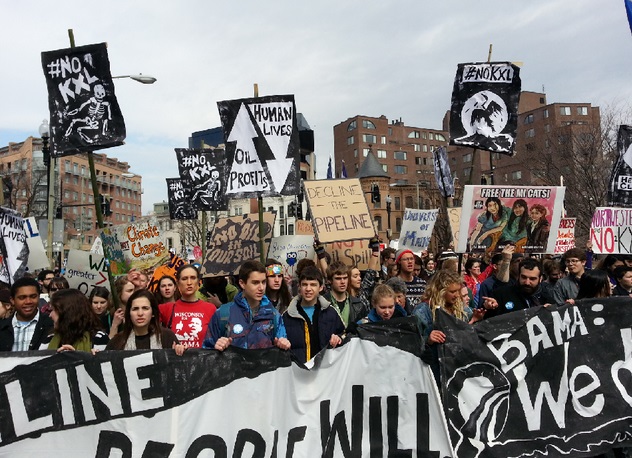by Stuart Brown
March 3, 2014
It was a feeling I had as I approached the gathering point inside the campus of Georgetown University yesterday morning. Perhaps it was just a feeling, the mood I was in. I’m not sure. But I was soon able to identify its source: young people expressing an elemental outrage over government policy that makes no sense to their humanity. You could feel it. The outrage was coming from their hearts.

Young people gathered by the thousands in Washington, DC on Sunday to demand the Obama Administration reject the Keystone XL tar sands pipeline. (Photo: @OccupyWallStreetNYC)
I tried to remember the last time I felt that same sense of outrage as I approached a demonstration. I had to reach back to the movement against the Vietnam war.
I have been to a lot of demonstrations between the Vietnam war and yesterday, of course. They were, for the most part, demonstrations worthy of my time and energy. And at each one we expressed our sense of outrage over whatever injustice or imperial policy we might have been protesting. But it seems to me that, for the most part, the outrage we expressed came from our heads, from an intellectual understanding, an overtly political understanding. I’m not saying that there aren’t always individuals who are feeling demands on a gut level and protest for this reason. I think there always are. I am referring to the general mood in the crowd, among the speakers, expressed in the signs and slogans. This time it felt different to me.
It was different, too, from Occupy Wall Street where I do believe that the outrage was heartfelt among the core of participants, because yesterday’s action had a clear and direct political focus: to stop the Keystone XL pipeline. Just as with the prevailing slogan during the anti-war movement, “Out Now!”, our calls of “Stop Now!” were demanding something that might be tangibly measured.
This was not, of course, the biggest demonstration I have been to since the Vietnam war. In fact, the turnout (I would say around 1000) was disappointing to me, based on the buildup I had seen and the urgency of the issue. It was surely too small to achieve its stated objective, even to give President Obama much cause to hesitate. It was also another predominantly white demonstration on an issue that affects every human being on the planet (though that’s one more way it was similar to most anti-Vietnam war protests). Still, it had this wonderful sense of outrage directed at a very specific policy of the present US administration.
“Stop Now!” “Leave the carbon in the soil!”
If I am going to be completely honest, I also have to add that the civil disobedience part of the demonstration, while certainly meaningful as a symbolic protest, did not give me the same feeling of spontaneous outrage that motivated the draft-card burners or sit-ins at induction centers during the 1960s. It all seemed just a bit too polite and well-choreographed with the police. But then, it’s early days yet. The first Vietnam protests were not as angry and confrontational as the movement later became.
It is worth commenting too, I think, on something else that was different yesterday from the movement that emerged in the 1960s. The left, for the most part, was absent. I saw two people selling Socialist Worker and not a single other newspaper. The only leaflet being handed out was by the Ecosocialist Contingent I marched with–sponsored by the System Change Not Climate Change coalition (where two overtly socialist groups, the International Socialist Organization and Solidarity, do play key roles along with the Green Party). By contrast, the organized left, and I mean the entire organized left, was all over the beginning of the anti-Vietnam war movement. Indeed, the antiwar movement might not have grown into the effective political force it became without the participation of the organized left.
Don’t get me wrong. I actually appreciated an atmosphere that wasn’t dominated by left groups, with their newspapers and leaflets. But it did make me wonder where the left was, which in turn makes me wonder whether the present organized left in the US might be missing the rebirth of a mass movement in this nation that will feed on an elemental sense of outrage among young people, focused directly at one specific set of policies of the US government. It was this same kind of sentiment which, when confronted with the intransigence of the Johnson and Nixon administrations during the 1960s and 70s, transformed thousands of youth who went to a first demonstration armed with nothing more than their elemental sense of humanity into conscious revolutionaries.
I can’t say for sure, of course, that this is the kind of movement that is developing once again. But I did have a certain feeling as I approached the gathering point yesterday morning. Perhaps it was just a feeling, the mood I was in. Then again, perhaps not.
